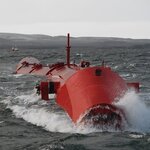Energy

A British company says they have a solution to the over 22,000 tons of hazardous waste that ends up in UK landfills annually from Alkaline batteries that are thrown away after being used in toys and gadgets, creating a toxic problem for hundreds of years.
Moixa Energy's award winning USBCELL re-usable batteries could help reduce this, they say, as they can be re-used hundreds of times by re-charging in USB ports on desktops, laptops or games consoles, saving consumers from money and helping the planet. USBCELLs were recently a Good Housekeeping consumer awards finalist and in September won…

Researchers in Nevada are reporting that waste coffee grounds can provide a cheap, abundant, and environmentally friendly source of biodiesel fuel for powering cars and trucks. Their study appears in the current online issue of ACS' Journal of Agricultural and Food Chemistry, a bi-weekly publication.
In the new study, Mano Misra, Susanta Mohapatra, and Narasimharao Kondamudi note that the major barrier to wider use of biodiesel fuel is lack of a low-cost, high quality source, or feedstock, for producing that new energy source. Spent coffee grounds contain between 11 and 20 percent oil by…

For the first time, researchers at the UCLA Henry Samueli School of Engineering and Applied Science have successfully pushed nature beyond its limits by genetically modifying Escherichia coli, a bacterium often associated with food poisoning, to produce unusually long-chain alcohols essential in the creation of biofuels.
"Previously, we were able to synthesize long-chain alcohols containing five carbon atoms," said James Liao, UCLA professor of chemical and biomolecular engineering. "We stopped at five carbons at the time because that was what could be naturally achieved. Alcohols were…

As early as 1890, people were beginning to think about harnessing the power of the ocean. During the twenty-year span between 1890 and 1910, there were wave power generation stations built all along the Southern California coast. The advent of cheap petroleum coming straight from the ground, however, has taken the focus off of energy generation solutions such as wave power for decades now, and as a result the only surviving wave motor from the large Southern California program is buried in the sand at the foot of the Manhattan Beach pier. Now, thanks to the huge push toward green energy…

In pursuing cleaner energy there is such a thing as being too green. Unicellular microalgae, for instance, can be considered too green.
In a paper in a special energy issue of Optics Express, scientists at the University of California, Berkeley describe a method for using microalgae for making biofuel. The researchers explain a way to genetically modify the tiny organisms, so as to minimize the number of chlorophyll molecules needed to harvest light without compromising the photosynthesis process in the cells. With this modification, instead of making more sugar molecules, the microalgae…

If changing the batteries in the remote control or smoke detector seems like a chore, imagine having to change hundreds of batteries in sensors scattered across a busy bridge. That's why Kansas State University engineers are helping a semiconductor manufacturer implement its idea of an energy-harvesting radio. It could transmit important data -- like stress measurements on a bridge, for instance -- without needing a change of batteries, ever.
Bill Kuhn, K-State professor of electrical and computer engineering, and Xiaohu Zhang, master's student in electrical engineering, are developing…

New technology is often called 'the wave of the future' but it couldn't be any more literal in the case of wave energy. Wave energy can be a large, widespread renewable resource that is environmentally benign and readily scalable. In some locations — the northwestern coasts of the United States, the western coast of Scotland, and the southern tips of South America, Africa and Australia, a wave-absorbing device could theoretically generate 100 to 200 megawatts of electricity per kilometer of coastline. But designing a wave-capture system that can deal with the harsh, corrosive…

RISI today through its Wood Biomass Market Report, indicated that woodfiber will play a major role in any new green energy spending plans in the U.S. The Report stated that as of Dec. 12, estimates from the ever-expanding federal stimulus package suggest the green component (wood, wind, solar, etc.) will be a whopping US$50 billion over two years. If 20% falls to wood energy, that near term spending of US$10 billion would spur formidable growth, providing tens of thousands of new jobs -- and wood demand of perhaps 120 million green tons, long-term.
Compared to an estimated 215 green tons of…

If there is a bailout of the Big Three, it should include alternative energy metrics against which the three companies compete for better loan repayment terms. The company that most rapidly converts its’ entire fleet to an average of 45 mpg, starts mass production of electric plug in and electric hybrid cars should have significantly better terms – including forgiveness of most of the loans – than the company that comes in second. There has been much discussion about whether America can afford to allow its’ auto industry to go down the tubes. This implies that the Big Three represent the…
Converting forests or fields to biofuel crops can increase or decrease greenhouse gas emissions, depending on where – and which – biofuel crops are used according to researchers at University of Illinois.
Scientists analyzed data from dozens of studies to determine how planting new biofuel crops can influence the carbon content of the soil. Their findings appear this month in the journal Global Change Biology Bioenergy.
Plants use the sun's energy to convert carbon dioxide from the atmosphere into the organic carbon that makes up leaves, stems and other plant parts. As plants decay,…